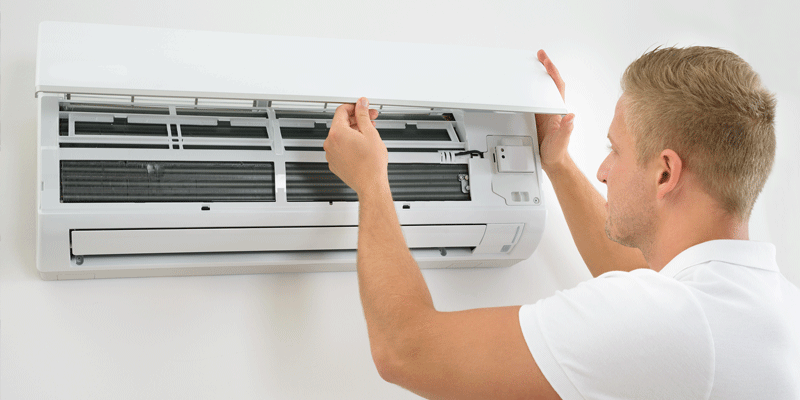
Is your air conditioning unit outdated or starting to have issues effectively cooling your indoor space? Are you considering a new style of AC unit but unsure which is the best choice for your home? There are different types of HVAC units available for home and business owners in the Austin, Texas area, each providing a unique set of functions and benefits. Below you can read about five common types of air conditioners and the steps you can take to determine the best type of AC for your home!
Window AC Units
One of the most popular and affordable types of air conditioner, a window unit is a great choice for cooling a specific room in your home without taking up floor space. Window air conditioning units are known to be one of the most efficient cooling systems available, as well as versatile due to the variable unit size. This type of AC is a single unit that rests in a window and has accordion panels to ensure a secure fit.
Benefits:
Simple to install
Affordable
Does not take up floor space
Quick and efficient cooling
Disadvantages:
Obstructs the entire window
May not be available for odd sizes/unique window shapes
Visible from the outside of the home
Can be noisy both inside and outside
Ductless Mini-Split
This specific style of air conditioner is minimalistic and perfect for those who are looking for a quick install with minimal disruption. These air conditioning units do not require ductwork, meaning there is no need to open walls or ceilings in your home to install these systems. The minimalist aesthetic of these types of air conditioners makes them a great addition to modern homes or smaller spaces. With a ductless mini-split, there is an indoor unit that blows cold/warm air and an outdoor compressor.
Benefits:
No ductwork means an easy installation
Sleek appearance
Ability to cool or heat
Control temperature by room
Disadvantages:
Can be expensive if installing multiple units
One unit may not be enough for your whole house
A wall-mounted unit may disrupt aesthetics
Heat Pump/Hybrid System
These unique hybrid systems function as a standard air conditioning unit, but have the ability to also heat your indoor space in addition to cooling. Some heat pump systems have the ability to sense temperature changes and can switch functions from heating to cooling automatically! Visually, these systems are similar to a central air conditioning unit with indoor and outdoor pieces. It’s important to note that these systems can struggle during the cold months and it’s common for a furnace to be used as a backup heating source.
Benefits:
Lower carbon footprint
Efficient heating and cooling functions
Low energy use means low electricity bills
Disadvantages:
High installation costs
May not function during freezing temperatures
Can be expensive to repair or replace
Year-round use means it may stop working sooner than a standard unit
Smart Air Conditioner
These high-tech “smart” air conditioners are typically a wall-mounted, portable, or ductless mini-split type unit that is IoT enabled. Essentially, this means that the AC unit is able to connect to Wi-Fi and functions can be controlled from your smartphone. There are countless features available with a smart air conditioner that make them simple to use and convenient for a variety of situations. Many homeowners choose a smart air conditioner so they are able to turn the unit on or off when weather changes or temperatures increase and they are away from their homes.
Benefits:
Convenient high-tech features
Simple to use
Can control the unit while away from the house
Energy-efficient
Disadvantages:
Need Wi-Fi to use the unit
Can be expensive compared to standard units
May be expensive to repair
Central Air Conditioning
A central air conditioning system is the perfect choice for those who have a large home or want to cool multiple areas at once. These in-depth systems use ductwork to provide temperature regulation through your home and contain both an indoor and outdoor unit. These systems function as regular air conditioning units but have the power and tools needed to cool an entire house!
Benefits:
Ability to cool an entire home
Cools faster than standard units
Lower humidity in the air
Can be used with a programmable thermostat
Disadvantages:
Large outdoor unit can affect aesthetics
Ductwork can become damaged or clogged
High energy usage means higher electricity bills
Consider BTUs and Cooling Range
Now that you know about the common types of air conditioning units, it’s important to understand BTUs and how that can affect the cooling range or efficiency of an AC in your space. BTUs (British thermal units) are essentially a measurement of an air conditioner’s heating or cooling ability based on the square footage of a space. For example, 6,000 BTUs may be great for a small bedroom but not so efficient for an entire floor of a house. 12,000 BTUs can cool an entire basement but may be too powerful for a guest bedroom. Understanding BTUs and the cooling range of an AC will help you to choose the best one for your interior space.
Contact Austin AC for AC Installation
If you are considering a new air conditioning unit for your Texas home, reach out to the team of NATE-certified HVAC experts at Austin AC! The team has extensive knowledge of the different types of air conditioners and can help you determine which is the best choice for your home. You can also reach out to Austin AC via phone or email to receive a free estimate on the cost of a new air conditioner installation!
